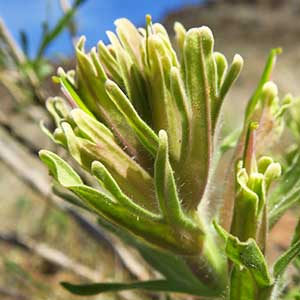Castilleja xanthotricha
Castilleja chrysantha
John Day or yellow-hairy paintbrush, John Day paintbrush, yellow hair paintbrush, yellow-hair Indian paintbrush
Wallowa paintbrush, yellow paintbrush, yellow Wallowa Indian paintbrush, yellowish or common Wallowa paintbrush
few to several, ± decumbent to erect or ascending, unbranched, sometimes with short, leafy axillary shoots, hairs erect to spreading, long, soft, eglandular, mixed with short stipitate-glandular ones.
few to many, erect or ascending, often decumbent at base, unbranched, sometimes branched, hairs spreading, long, soft, mixed with dense, shorter stipitate-glandular ones.
green, linear, lanceolate to broadly lanceolate, oblong, or cuneate, 0.8–5 cm, not fleshy, margins plane to wavy, involute, 0–5-lobed, apex acute, sometimes rounded;
lobes spreading, linear, arising below mid length, nearly as broad as center lobe, apex acute.
green or purple-tinged, sometimes deep purple, broadly lanceolate, sometimes linear-lanceolate or narrowly oblong, 1.5–4.8 cm, not fleshy, margins plane, flat or involute, 0–3-lobed, apex acute;
lobes ascending or spreading, linear to narrowly linear or narrowly lanceolate, short, apex acuminate.
3–14 × 1.5–4.5 cm;
bracts proximally greenish, rarely dull reddish purple, distally white to cream, rarely pale yellow or dull, pale pink (sharply differentiated from proximal coloration), lanceolate or oblong to narrowly ovate, (3–)5–7-lobed;
lobes ascending, linear to obovate, ± broadened distally, medium, long, proximal lobes arising below mid length, central lobe apex broadly rounded to truncate, others acute to rounded.
3–17 × 1–3 cm;
bracts greenish or pale yellow-green throughout, or proximally greenish or pale yellow-green, distally pale yellow to whitish, sometimes pink-purple, or pale, dull purplish, sometimes aging pink or yellow, often infused with light purple, rarely pink, ovate to broadly acute, (0–)3-lobed;
lobes ascending, linear-lanceolate, oblong, or triangular, short, arising below mid length, apex acute to obtuse.
curved, 17–23 mm;
tube 15–19 mm;
beak exserted, adaxially green, 5–8(–9) mm, puberulent, stipitate-glandular;
abaxial lip deep purple (color sometimes visible through calyx), green, pinkish, or pale yellow, ± prominent, slightly inflated, usually hidden in calyx, sometimes right at top of calyx, 2 mm, ca. 50% as long as beak;
teeth ascending, whitish, yellowish, pink, or green, 1–1.5 mm.
straight, (16–)20–25 mm;
tube 15–18 mm;
beak slightly exserted, adaxially green to yellow, 5.5–8.5 mm;
abaxial lip white, green and white, pink, or purple, ± prominent, appressed (proximally scarcely or not pouched), 3–5 mm, 67% as long as beak;
teeth erect, white or pink with some purple or red, 1.5–2.5 mm.
colored as bracts, 15–26 mm;
abaxial and adaxial clefts 3.5–7 mm, 25–50% of calyx length, deeper than laterals, lateral 2–5 mm, 12–25% of calyx length;
lobes linear, oblong, or narrowly triangular, center lobe apex usually rounded, lobes acute to rounded.
proximally green, pale with green veins, purple-tinged green, or purple, distally pale yellow, white, or purplish, 12–20 mm;
abaxial and adaxial clefts 8–12 mm, 50% of calyx length, deeper than laterals, lateral 0.5–3 mm, 5–15% of calyx length;
lobes short-triangular, apex obtuse, rounded, or truncate.
= 48.
Castilleja xanthotricha
Castilleja chrysantha
Castilleja xanthotricha is endemic to moderate elevations in the sagebrush hills of the John Day River drainage in north-central Oregon. N. H. Holmgren (1971) hypothesized that this tetraploid species is of allopolyploid hybrid origin between C. glandulifera and C. oresbia.
(Discussion copyrighted by Flora of North America; reprinted with permission.)
Castilleja chrysantha is endemic to the mountains of northeastern Oregon, and its patterns of variation need further study. Most plants in the Blue Mountains are taller, more erect, and tolerate lower elevation habitats than populations around the type locality in the Wallowa Mountains. Plants with purplish inflorescences and longer hairs were described as C. ownbeyana and tend to favor drier talus and ridges than plants like the type, found in flat, mesic, montane to subalpine meadows. Hybrids between C. chrysantha and C. fraterna occur in Wallowa County. In the Wallowa Mountains, a recurrent and variable hybrid form between C. chrysantha and C. rhexiifolia was described as C. wallowensis Pennell.
(Discussion copyrighted by Flora of North America; reprinted with permission.)
